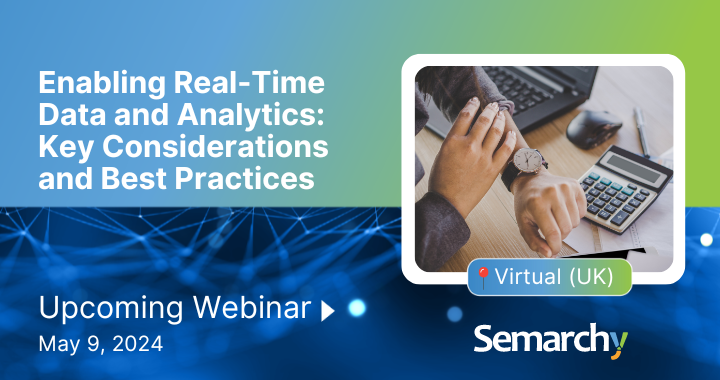Energy’s Data-Driven Future
Energy and Renewable organizations are heading for a digital future – but is their data up to the task? Semarchy’s James Payne explains how Energy Master Data Management (MDM) can help.
Energy and Renewable firms are becoming overloaded with data. It’s a useful resource, but if it’s not managed correctly, it’s not going to drive the digital future the sector needs to thrive in a challenging environment.
Agile Solutions and Semarchy have worked together on several energy MDM projects in the sector, helping Energy and Renewables businesses to tackle their challenges and get value from data.
Here James Payne, Director of Sales at Semarchy and an expert in MDM for the energy renewables market, explains the role of MDM in creating a data-driven future for Energy and Renewables, as well as sharing some practical tips to making MDM a success.
So James, what are the biggest data challenges for Energy and Renewables firms right now?
I always like to look at what the actual business challenges are before recognizing the data challenges. Over the last few years, it’s been a challenging market, not just for the energy sector but every business, and a lot of the challenges that are affecting other industries are also affecting the Energy and Renewables sector. Covid has caused supply chain difficulties and rising costs. Then there’s trade policy uncertainty, inflation, increasing interest rates and delays due to lockdowns… these are all having an impact. We’re now seeing renewed investment into a change in the sector, with a lot of investments and incentives going into renewables, with initiatives from several countries to try and drive that market forward again.
In terms of data challenges, we’re seeing a similar push for change. In Energy and Renewables, you have these very large organizations that have grown over a long period of time through mergers and acquisitions. This M&A has happened at an accelerated rate over the last couple of years, as some of the smaller companies haven’t been able to weather the storm. What then happens is you have a data landscape that has many, many different sources of data. So you might have one particular data domain that sits in 10, 20 different systems. And it’s all in different technologies, and therefore different data formats. The challenge is that bringing these together and really getting insights and value out of that data causes a lot of difficulties: in data quality, governance, and having a common understanding of what these terms mean. There are things that are very, very prevalent in this market.
How can energy MDM help them to overcome these obstacles and use their data more effectively?
MDM gives you the ability to access all of that data, across all of these different sources. The big advantage that an MDM solution brings is actually being able to look at the state of your data: how much of it there is, how incomplete it is, how high quality it is, and so on. Secondly, you want to bring that data together. Once you’ve seen your data and answered those questions, you can address the quality challenges with your data and see patterns arising in the quality and trustworthiness of certain sources.
For the Energy and Renewables sector, having visibility of key data assets – customer, asset, location, etc – is very important. You really want to be able to pull all of this information together and get the best version of the truth that you can, that can be used in several different initiatives, whether it’s operational, insights, analytics, decision-making, customer service, or something else. With MDM you can really understand what’s going on across your organization, as well as push the right information out into operational systems to aid with day-to-day running and decision-making.
What could a data-driven future look like for the Energy and Renewables sector?
This is a really interesting one, because I think there are two big future trends.
First is decentralization of energy production. There are a lot of new companies entering the renewables market and a lot of chances for new centres of energy production to arise. Rather than the very centralized grid that we have had in the past, which has been run by these large organizations, we’re moving into a phase where new investments are coming into the renewables market. It’s going to give the opportunity for smaller organizations, with renewable power production and energy production, to start putting energy into the grid.
This decentralization isn’t just limited to companies: there’s also the trend for consumer-led energy production. I read recently about an initiative in Scotland where they’re looking to encourage house builders to start incorporating energy production into new buildings by giving out incentives and grants. This is creating a lot of different scenarios. First of all, it creates a higher volume of data. We find ourselves in a situation where we’re producing and detecting multiple different sources again, across multiple different organizations – which is going to reveal all of those data issues we just talked about.
So the future could look really good if you have a good data strategy and you’re able to really understand your data, see where that energy is coming from, and where the energy is translating into value for money.
This ties into the second trend, digitalization of the market. A decentralized grid is reliant on smart devices, the Internet of Things (IoT). It’s reliant on the digitalization of the market. IoT is a key piece of AI and predictive analytics, that both needs data and generates huge volumes of it. The sector needs to be ready for that.
MDM success is about culture as well as technology – what’s your advice to customers when implementing energy MDM?
As with all MDM projects: people and processes are as much part of MDM’s culture of change as the technology. There are some key things that you can do very early on once you’ve decided on implementing MDM.
The first of those is to get yourself a business sponsor who is on board with helping drive it. The most successful MDM projects are the ones that have an MDM sponsor from the business, not IT. An IT-led project can often find it really difficult to change processes: when you have a business sponsor, you recognize what the business value is going to be in delivering an MDM project, rather than just the technical value and challenges that you get. A business sponsor can list out the business pains you have, map them to the technical pains that you have, and therefore create something far more palatable when it comes to actually implementing these cultural changes.
The second piece of advice is to recognize that the market has changed. MDM used to be a very difficult, long project that you would undertake with a lot of risks, but it isn’t any more. MDM is now far more usable and easy to implement. You can reach value with MDM within the space of three months. You start recognizing business value early on as well as understand, report and measure the business value at shorter intervals.
Thirdly, it’s back to that culture piece: it’s bringing people along for the ride with you. Show that you can actually deliver value and show business users, as well as business leaders, what improvements MDM can bring. Constantly keep them involved in a feedback loop that you can then look to improve on with the next iteration of the tool.
How do Semarchy and Agile Solutions work together to help Energy and Renewable organizations with their energy MDM challenges?
I’ve worked with Agile Solutions on projects throughout my whole career, and they are one of the best thought leaders for MDM and data in the UK. They’ve continued to deliver on countless projects, both within the Energy and Renewables space and in other sectors.
As a result, they have a good knowledge of what the business challenges are, as well as they have incredible knowledge of what the technical challenges are – and that’s where organizations like Agile Solutions provide additional value.
Partnering with an organization such as Agile, help guide our customers into delivering on those other two distinct pieces of MDM: people, and technology.
It’s also about speed of delivery. With Agile, we provide a solution that’s very flexible, it’s cloud-based and quick and easy to deploy. Within three months, you can have a solution up and running and start realizing value very, very early on. That enables the organizations that we work with to not only see quicker time to value, but also to have far less risk in taking on a project like this. You end up with the lowest risk and highest value.
Is your data ready to drive your digital future? To find out what you need to do to implement MDM, and how it will impact your strategy long into the future, download Agile Solutions’ guide: Power up with MDM: Fuel your data strategy with high-quality master data.
Want to learn more? Contact us today for a demo.



